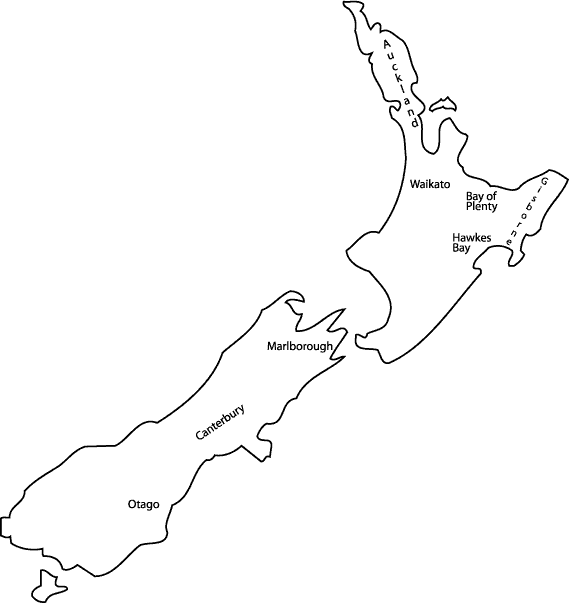
New Zealand
 Overview
Overview
Like its neighbor Australia, New Zealand was settled in a large part by the English. Here too, wine making was an early goal and vines were planted all around the North and South Islands.
The climate in New Zealand can be cool, and even cold in places. This may have influenced the early grape growers to choose varieties more at home in cooler regions than New Zealand turned out to be. It takes time for people, much less an entire industry, to learn it has made a mistake, and to adapt.
In the 1980s too many wines from New Zealand had a flavor that can only be described as canned asparagus. This was true for red and white wines, and it was hampering the forward progress of the industry. Around this time the new Australian vineyard management techniques started to catch on in New Zealand, perhaps faster than even in Australia. This new way of looking at growing grapes, as well as the general attention that was being paid to New Zealand wines, paid off.
The wines of New Zealand today rarely exhibit the problems of the past, and new regions are yielding exciting wines to explore. As with so many other parts of the world, New Zealand is undergoing a wine revolution, and early indications are promising.
The Regions
Auckland - The wine region in New Zealand's north island, centered around the city of the same name.
Bay of Plenty - A wine producing region on New Zealand's north island.
Canterbury - A large wine region on the south island of New Zealand. The region is almost too large and varied to make general comments about, but it is certainly a region that is still looking for its identity. Many of the vineyards are planted to white varieties, notably Riesling and Chardonnay, in an attempt to make the best of what may be too cool of a climate. The cold temperatures mean that some vineyards in this region may have problems ripening in certain vintages.
Gisborne - A wine region on the north island of New Zealand. Situated on the east coast, this region is one of the largest by volume. Many of the grapes are used by the large producers, and as such there are not many wineries here. Chardonnay is the main grape of the region. Hawkes Bay Sometimes referred to in the press as the "Bordeaux of New Zealand." The inference is not only due to the Cabernet and Merlot based wines from the region, but as well to the variability of vintages that plagues Hawkes Bay. Chardonnay and rich, oak aged Sauvignon Blanc are the whites of the region.
Marlborough - Possibly New Zealands finest wine region. Located on the northern end of the southern island, Marlborough is a cool growing region with long dry autumns. This is important since the grapes would not have a chance to ripen fully if the region had rain around the time of the harvest. Sauvignon Blanc made the region well known, but it is Pinot Noir that may ultimately make its mark on Marlborough.
Otago - The southernmost wine region in New Zealand. In fact, the southernmost wine region in the World. Nestled in the mountains, the climate is different than almost anywhere else in New Zealand. Vineyards, reminiscent of those in Germany's Mosel (one of the northernmost growing regions) are perched on hillsides with an exposure designed to eke out every bit of solar radiation possible. Pinot Noir is being planted here, as is Riesling. These grapes too are found in the cool climates of Germany, and the comparison is inevitable. Time will tell how this region does, as most of the plantings are fairly recent, but there are high hopes.
Waikato - A wine region in New Zealand's northern island.
New Zealand wine labels
Most wines are labeled by the grape variety, rather than the place name.
Copyright WineEducation.com
Do not reprint without permission